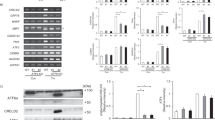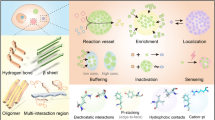Abstract
Heat shock proteins of 40 kDa (Hsp40s), also called J proteins, are obligate partners of Hsp70s. Via their highly conserved and functionally critical J domain, J proteins interact and modulate the activity of their Hsp70 partners. Mutations in the critical residues in the J domain often result in the null phenotype for the J protein in question. However, as more J proteins have been characterized, it is becoming increasingly clear that a significant number of J proteins do not “completely” rely on their J domains to carry out their cellular functions, as previously thought. In some cases, regions outside the highly conserved J domain have become more important making the J domain dispensable for some, if not for all functions of a J protein. This has profound effects on the evolution of such J proteins. Here we present selected examples of J proteins that perform J domain independent functions and discuss this in the context of evolution of J proteins with dispensable J domains and J-like proteins in eukaryotes.


Similar content being viewed by others
References
Bukau B, Horwich AL (1998) The Hsp70 and Hsp60 chaperone machines. Cell 92:351–366
Cao M et al (2014) DnaJA1/Hsp40 is co-opted by influenza A virus to enhance its viral RNA polymerase activity. J Virol 88:14078–14089. doi:10.1128/JVI.02475-14
Caplan AJ, Douglas MG (1991) Characterization of YDJ1: a yeast homologue of the bacterial dnaJ protein. J Cell Biol 114:609–621
Caplan AJ, Cyr DM, Douglas MG (1992) YDJ1p facilitates polypeptide translocation across different intracellular membranes by a conserved mechanism. Cell 71:1143–1155
Chai Y, Koppenhafer SL, Bonini NM, Paulson HL (1999) Analysis of the role of heat shock protein (Hsp) molecular chaperones in polyglutamine disease. J Neurosci 19:10338–10347
Cheetham ME, Caplan AJ (1998) Structure, function and evolution of DnaJ: conservation and adaptation of chaperone function. Cell Stress Chaperones 3:28–36
Craig EA, Huang P, Aron R, Andrew A (2006) The diverse roles of J-proteins, the obligate Hsp70 co-chaperone. Rev Physiol Biochem Pharmacol 156:1–21
Cyr DM (1995) Cooperation of the molecular chaperone Ydj1 with specific Hsp70 homologs to suppress protein aggregation. FEBS Lett 359:129–132
D’Silva P, Liu Q, Walter W, Craig EA (2004) Regulated interactions of mtHsp70 with Tim44 at the translocon in the mitochondrial inner membrane. Nat Struct Mol Biol 11:1084–1091. doi:10.1038/nsmb846
Ducett JK, Peterson FC, Hoover LA, Prunuske AJ, Volkman BF, Craig EA (2013) Unfolding of the C-terminal domain of the J-protein Zuo1 releases autoinhibition and activates Pdr1-dependent transcription. J Mol Biol 425:19–31. doi:10.1016/j.jmb.2012.09.020
Eisenman HC, Craig EA (2004) Activation of pleiotropic drug resistance by the J-protein and Hsp70-related proteins, Zuo1 and Ssz1. Mol Microbiol 53:335–344. doi:10.1111/j.1365-2958.2004.04134.x
Fimia GM, Gottifredi V, Bellei B, Ricciardi MR, Tafuri A, Amati P, Maione R (1998) The activity of differentiation factors induces apoptosis in polyomavirus large T-expressing myoblasts. Mol Biol Cell 9:1449–1463
Gautschi M, Mun A, Ross S, Rospert S (2002) A functional chaperone triad on the yeast ribosome. Proc Natl Acad Sci U S A 99:4209–4214. doi:10.1073/pnas.062048599
Gillis J et al (2013) The DNAJB6 and DNAJB8 protein chaperones prevent intracellular aggregation of polyglutamine peptides. J Biol Chem 288:17225–17237. doi:10.1074/jbc.M112.421685
Gjoerup O, Chao H, DeCaprio JA, Roberts TM (2000) pRB-dependent, J domain-independent function of simian virus 40 large T antigen in override of p53 growth suppression. J Virol 74:864–874
Greene MK, Maskos K, Landry SJ (1998) Role of the J-domain in the cooperation of Hsp40 with Hsp70. Proc Natl Acad Sci U S A 95:6108–6113
Guan J, Ekwurtzel E, Kvist U, Hultenby K, Yuan L (2010) DNAJB13 is a radial spoke protein of mouse ‘9+2’ axoneme. Reprod Domest Anim 45:992–996. doi:10.1111/j.1439-0531.2009.01473.x
Hageman J et al (2010) A DNAJB chaperone subfamily with HDAC-dependent activities suppresses toxic protein aggregation. Mol Cell 37:355–369. doi:10.1016/j.molcel.2010.01.001
Hainzl O, Wegele H, Richter K, Buchner J (2004) Cns1 is an activator of the Ssa1 ATPase activity. J Biol Chem 279:23267–23273. doi:10.1074/jbc.M402189200
Hallstrom TC, Katzmann DJ, Torres RJ, Sharp WJ, Moye-Rowley WS (1998) Regulation of transcription factor Pdr1p function by an Hsp70 protein in Saccharomyces cerevisiae. Mol Cell Biol 18:1147–1155
Hennessy F, Nicoll WS, Zimmermann R, Cheetham ME, Blatch GL (2005) Not all J domains are created equal: implications for the specificity of Hsp40-Hsp70 interactions. Protein Sci 14:1697–1709. doi:10.1110/ps.051406805
Jin Y, Awad W, Petrova K, Hendershot LM (2008) Regulated release of ERdj3 from unfolded proteins by BiP. EMBO J 27:2873–2882. doi:10.1038/emboj.2008.207
Johnson JL, Craig EA (2001) An essential role for the substrate-binding region of Hsp40s in Saccharomyces cerevisiae. J Cell Biol 152:851–856
Jordan R, McMacken R (1995) Modulation of the ATPase activity of the molecular chaperone DnaK by peptides and the DnaJ and GrpE heat shock proteins. J Biol Chem 270:4563–4569
Jungkunz I, Link K, Vogel F, Voll LM, Sonnewald S, Sonnewald U (2011) AtHsp70-15-deficient Arabidopsis plants are characterized by reduced growth, a constitutive cytosolic protein response and enhanced resistance to TuMV. Plant J 66:983–995. doi:10.1111/j.1365-313X.2011.04558.x
Kampinga HH, Craig EA (2010) The HSP70 chaperone machinery: J proteins as drivers of functional specificity. Nat Rev Mol Cell Biol 11:579–592. doi:10.1038/nrm2941
Kota P, Summers DW, Ren HY, Cyr DM, Dokholyan NV (2009) Identification of a consensus motif in substrates bound by a Type I Hsp40. Proc Natl Acad Sci U S A 106:11073–11078. doi:10.1073/pnas.0900746106
Laufen T, Mayer MP, Beisel C, Klostermeier D, Mogk A, Reinstein J, Bukau B (1999) Mechanism of regulation of hsp70 chaperones by DnaJ cochaperones. Proc Natl Acad Sci U S A 96:5452–5457
Levy EJ, McCarty J, Bukau B, Chirico WJ (1995) Conserved ATPase and luciferase refolding activities between bacteria and yeast Hsp70 chaperones and modulators. FEBS Lett 368:435–440
Li W, Liu G (2014) DNAJB13, a type II HSP40 family member, localizes to the spermatids and spermatozoa during mouse spermatogenesis. BMC Dev Biol 14:38. doi:10.1186/s12861-014-0038-5
Liberek K, Marszalek J, Ang D, Georgopoulos C, Zylicz M (1991) Escherichia coli DnaJ and GrpE heat shock proteins jointly stimulate ATPase activity of DnaK. Proc Natl Acad Sci U S A 88:2874–2878
Liu Q, Krzewska J, Liberek K, Craig EA (2001) Mitochondrial Hsp70 Ssc1: role in protein folding. J Biol Chem 276:6112–6118. doi:10.1074/jbc.M009519200
Lopez N, Aron R, Craig EA (2003) Specificity of class II Hsp40 Sis1 in maintenance of yeast prion [RNQ+]. Mol Biol Cell 14:1172–1181. doi:10.1091/mbc.E02-09-0593
Lu Z, Cyr DM (1998) The conserved carboxyl terminus and zinc finger-like domain of the co-chaperone Ydj1 assist Hsp70 in protein folding. J Biol Chem 273:5970–5978. doi:10.1074/jbc.273.10.5970
Mayer MP (2004) Timing the catch. Nat Struct Mol Biol 11:6–8. doi:10.1038/nsmb0104-6
Mayer MP, Bukau B (2005) Hsp70 chaperones: cellular functions and molecular mechanism. Cell Mol Life Sci 62:670–684. doi:10.1007/s00018-004-4464-6
Mayer MP, Brehmer D, Gassler CS, Bukau B (2001) Hsp70 chaperone machines. Adv Protein Chem 59:1–44
Misselwitz B, Staeck O, Rapoport TA (1998) J proteins catalytically activate Hsp70 molecules to trap a wide range of peptide sequences. Mol Cell 2:593–603
Pishvaee B et al (2000) A yeast DNA J protein required for uncoating of clathrin-coated vesicles in vivo. Nat Cell Biol 2:958–963. doi:10.1038/35046619
Qiu XB, Shao YM, Miao S, Wang L (2006) The diversity of the DnaJ/Hsp40 family, the crucial partners for Hsp70 chaperones. Cell Mol Life Sci 63:2560–2570. doi:10.1007/s00018-006-6192-6
Rajan VB, D’Silva P (2009) Arabidopsis thaliana J-class heat shock proteins: cellular stress sensors. Funct Integr Genomics 9:433–446. doi:10.1007/s10142-009-0132-0
Sahi C, Craig EA (2007) Network of general and specialty J protein chaperones of the yeast cytosol. Proc Natl Acad Sci U S A 104:7163–7168. doi:10.1073/pnas.0702357104
Sahi C, Lee T, Inada M, Pleiss JA, Craig EA (2010) Cwc23, an essential J protein critical for pre-mRNA splicing with a dispensable J domain. Mol Cell Biol 30:33–42. doi:10.1128/MCB.00842-09
Sahi C, Kominek J, Ziegelhoffer T, Yu HY, Baranowski M, Marszalek J, Craig EA (2013) Sequential duplications of an ancient member of the DnaJ-family expanded the functional chaperone network in the eukaryotic cytosol. Mol Biol Evol 30:985–998. doi:10.1093/molbev/mst008
Shen Y, Hendershot LM (2005) ERdj3, a stress-inducible endoplasmic reticulum DnaJ homologue, serves as a cofactor for BiP’s interactions with unfolded substrates. Mol Biol Cell 16:40–50. doi:10.1091/mbc.E04-05-0434
Sheng Q, Love TM, Schaffhausen B (2000) J domain-independent regulation of the Rb family by polyomavirus large T antigen. J Virol 74:5280–5290
Stark JL et al (2014) Structure and function of human DnaJ homologue subfamily a member 1 (DNAJA1) and its relationship to pancreatic cancer. Biochemistry 53:1360–1372. doi:10.1021/bi401329a
Sullivan CS, Cantalupo P, Pipas JM (2000) The molecular chaperone activity of simian virus 40 large T antigen is required to disrupt Rb-E2F family complexes by an ATP-dependent mechanism. Mol Cell Biol 20:6233–6243
Tsai J, Douglas MG (1996) A conserved HPD sequence of the J-domain is necessary for YDJ1 stimulation of Hsp70 ATPase activity at a site distinct from substrate binding. J Biol Chem 271:9347–9354
Wagner I, Arlt H, van Dyck L, Langer T, Neupert W (1994) Molecular chaperones cooperate with PIM1 protease in the degradation of misfolded proteins in mitochondria. EMBO J 13:5135–5145
Walsh P, Bursac D, Law YC, Cyr D, Lithgow T (2004) The J-protein family: modulating protein assembly, disassembly and translocation. EMBO Rep 5:567–571. doi:10.1038/sj.embor.7400172
Wegele H, Haslbeck M, Reinstein J, Buchner J (2003) Sti1 is a novel activator of the Ssa proteins. J Biol Chem 278:25970–25976. doi:10.1074/jbc.M301548200
Xiao J, Kim LS, Graham TR (2006) Dissection of Swa2p/auxilin domain requirements for cochaperoning Hsp70 clathrin-uncoating activity in vivo. Mol Biol Cell 17:3281–3290. doi:10.1091/mbc.E06-02-0106
Yan W, Craig EA (1999) The glycine-phenylalanine-rich region determines the specificity of the yeast Hsp40 Sis1. Mol Cell Biol 19:7751–7758
Yan W, Schilke B, Pfund C, Walter W, Kim S, Craig EA (1998) Zuotin, a ribosome-associated DnaJ molecular chaperone. EMBO J 17:4809–4817. doi:10.1093/emboj/17.16.4809
Yan W, Gale MJ Jr, Tan SL, Katze MG (2002) Inactivation of the PKR protein kinase and stimulation of mRNA translation by the cellular co-chaperone P58(IPK) does not require J domain function. Biochemistry 41:4938–4945
Yang C, Owen HA, Yang P (2008) Dimeric heat shock protein 40 binds radial spokes for generating coupled power strokes and recovery strokes of 9 + 2 flagella. J Cell Biol 180:403–415. doi:10.1083/jcb.200705069
Author information
Authors and Affiliations
Corresponding author
Rights and permissions
About this article
Cite this article
Ajit Tamadaddi, C., Sahi, C. J domain independent functions of J proteins. Cell Stress and Chaperones 21, 563–570 (2016). https://doi.org/10.1007/s12192-016-0697-1
Received:
Revised:
Accepted:
Published:
Issue Date:
DOI: https://doi.org/10.1007/s12192-016-0697-1




